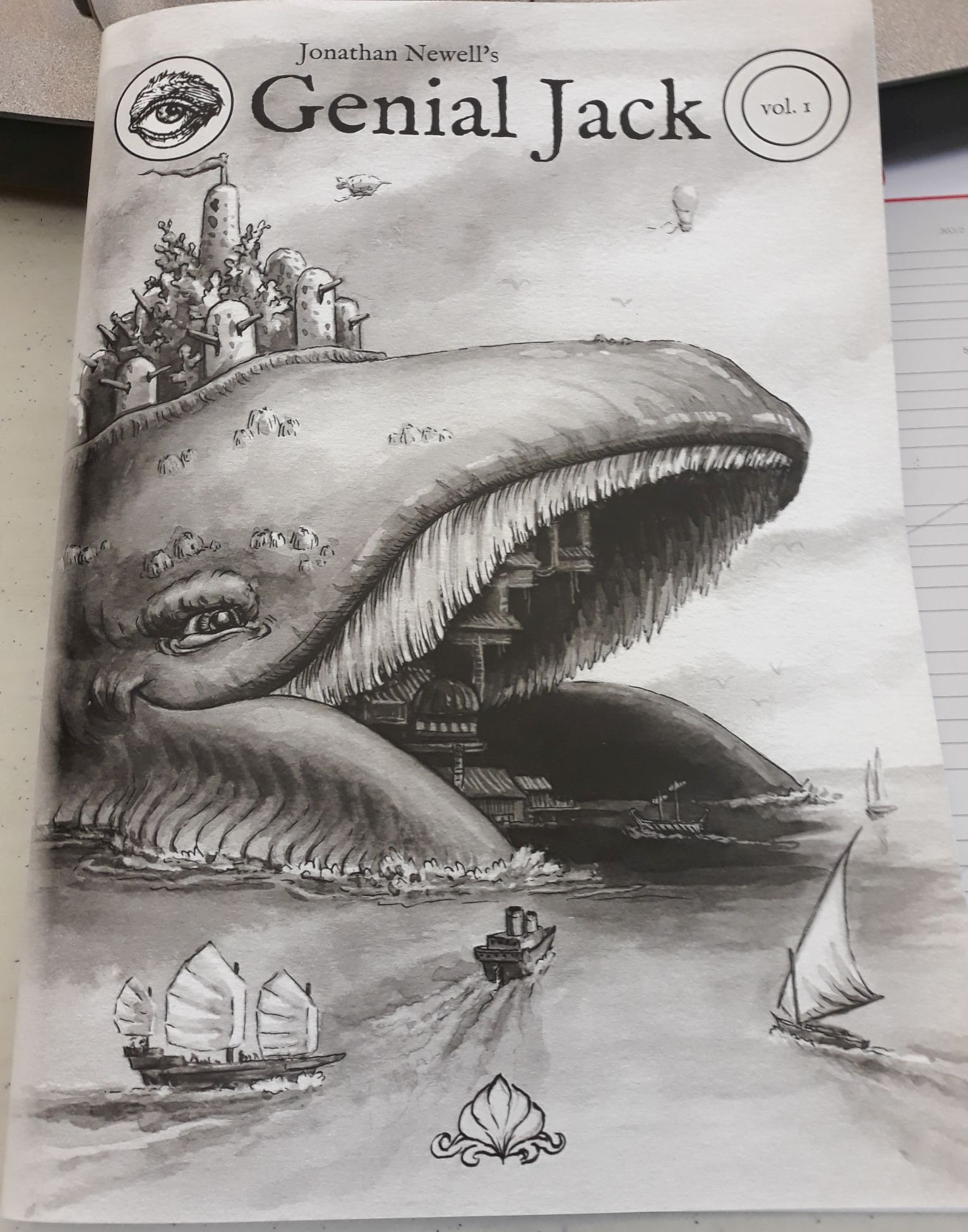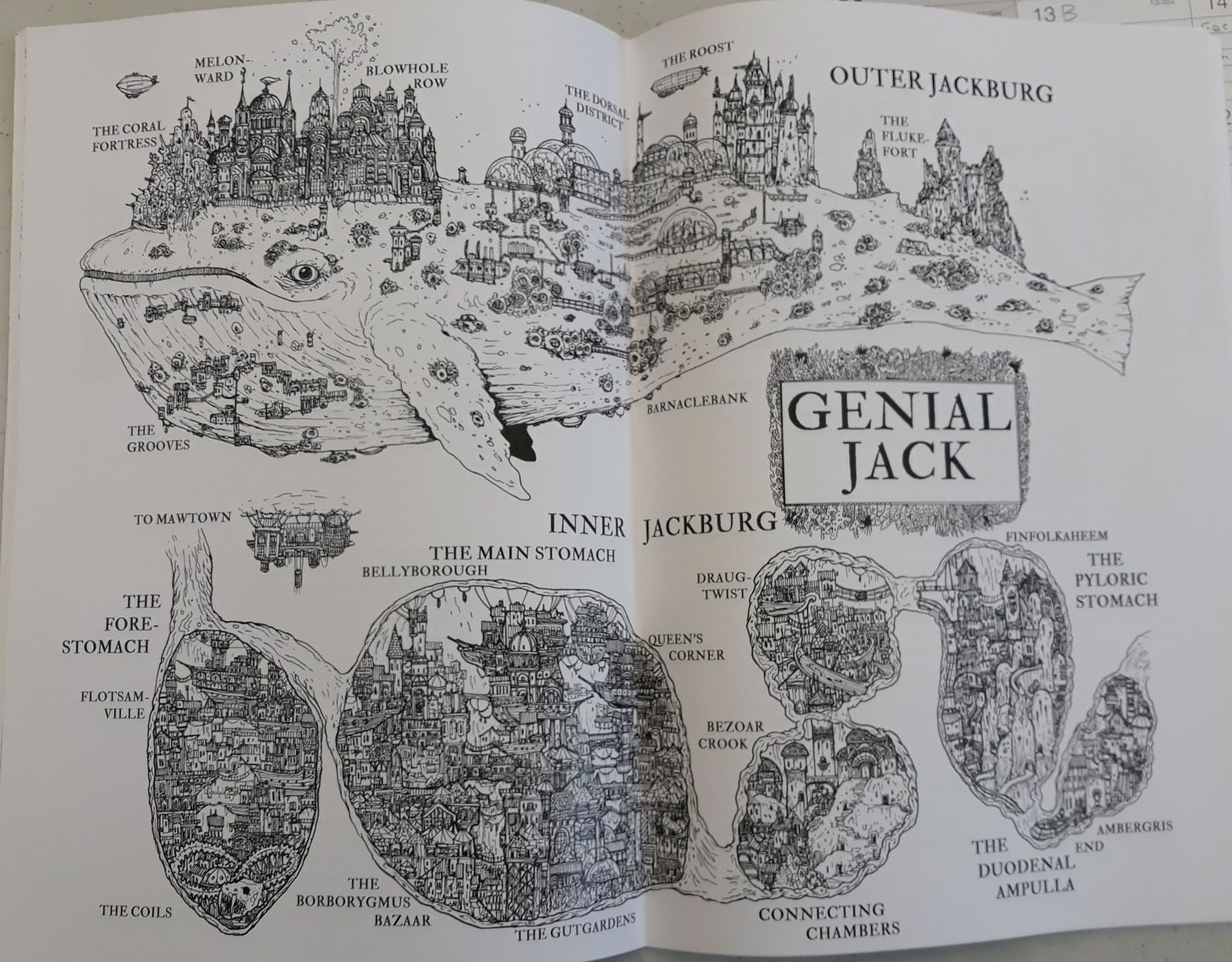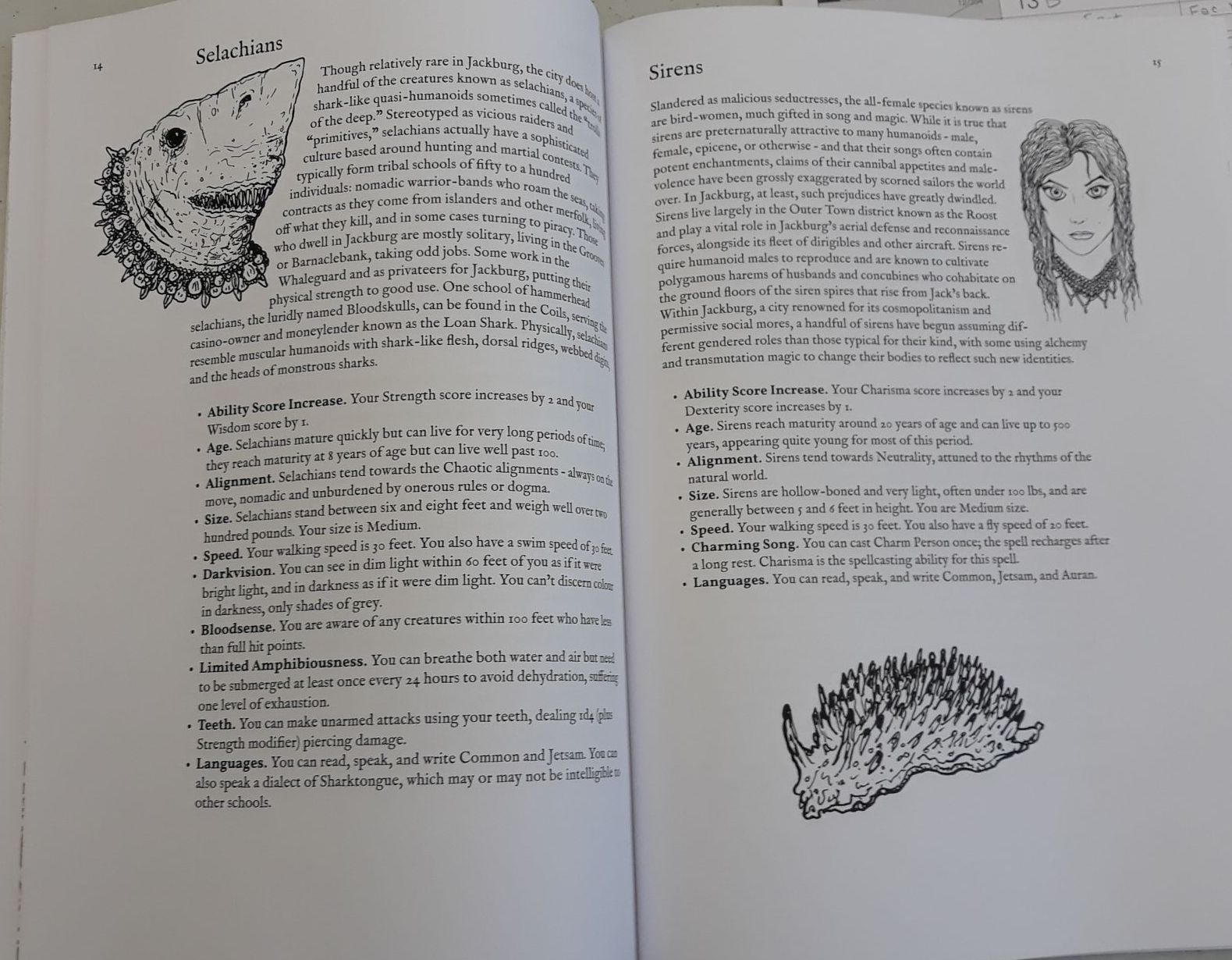Whale Ho!
Nota Bene: The first link below is an affiliate link. If you use it to purchase the PDF, then I got a few coppers. The second link is for the store that sells copies from the first print run (not print-on-demand as I mistakenly had thought). That’s the route I went. All direct quotes come from the book itself.
Jonathan Newell’s Genial Jack from Lost Pages astonishes from cover to cover. Within its 50ish 8.5-inch-by-11.5-inch pages, one finds a fascinating introduction to Genial Jack, “a whale the size of a mountain” that has been for hundreds of years “the host to the teeming town of Jackburg”. Oodles of creatures representing more than a dozen different races/species call the buildings both within and without Jack their home. Ships anchor in Jack’s cavernous mouth. Elevators climb Jack’s inner mouth to reach Mawtown. One can ride the Esophogeal Tram to reach the villages in Jack’s guts. If that’s not one’s cup of tea, then wander across Jack’s immense back, marveling at the Coral Fortress or sampling the wares of the Dorsal District. Able to breathe water? Then dive in and swim down to the Grooves or visit the Barnaclebank Fish Market. All along the way, rub elbows with Draugar, Finfolk, Fomorians, Jellyfolk, and nine other races ready for use as PCs.
After a short introduction that includes a bit of Jack’s history and suggestions about how to use Jack in your campaign, the book details the People. Each of the 13 races are presented on a single page along with a portrait of a representative member. The races include 5E D&D stats, and each is sufficiently detailed and different to avoid Finfolk seeming too much like Jellyfolk. Unsurprisingly, many of the races are aquatic. Each race has a niche carved out in or on Jack. For example, Octopoids “have become merchant princes and princesses par excellence, with tendrils in every business in the city.” The shark-like Selachians tend to live on the fringes of Jackburg society as they hail from “nomadic warrior-bands who roam the seas, taking contracts as they come from islanders and other merfolk, living off what they kill, and in some cases turning to piracy.” I like this approach to handling races. Each has its distinctive appearance, racial abilities, and a societal role within the context of the setting.
Oddly, none of the races have subraces. Perhaps these will be detailed in the next issue of the Genial Jack? If so, it seems an odd way to present the information. If not, it seems a blank space that begs the application of creativity by the players and DM.
Jackburg itself is divided into two sections: Outer Jackburg and Inner Jackburg. Multiple districts comprise each section, and Genial Jack doesn’t so much as detail the districts as it presents them in a few paragraphs of evocative text that introduce the general flavor of the district and then briefly describes possible encounters and noteworthy locations. The encounters and locations sections are like oysters. Pry them open, and one can find pearls, if by “pearls” one means hooks for adventures both short and long. Along the way, the reader gets to meet some of the power groups and movers-and-shakers of Jackburg, from the Whaleguards to spectral pirates to Selachian clerics serving the Sharkfather. Jackburg’s government, laws, and criminal organizations (of which there are five mentioned) also get some description as well.
Smack in the middle of the book is a wonderful double-page poster of Genial Jack, showing the locations of the different districts. It’s not really a map per se. There’s no scale, for example. A nice touch is that back of the right half of the poster includes examples of Jackburg slang. When a ratfolk ruffian says you’re “eelish”, you’ll know if that’s a good thing or a bad thing. (Hint: It’s not a good thing.) Then, if you’ve got the “cannonballs” for it, you can pummel him until he’s half “crab-eaten”.
One oddity is the back of the left half of the poster, which is blank. Page 26 talks about the Melonward district. Page 27 is nothing but white. Paolo Greco on DriveThruRPG explains that the page “is blank on purpose, when printed is the back of the removable centrefold.” I’m a bit meh about this. There should be something there. Perhaps more Jackburg slang? A typical tavern menu? Just about anything rather than a blank page. If you’re the type of person who would unbend staples to remove the center map, don’t fret. The two-page illustration of Genial Jack appears near the end of the book as well, right after Appendix A, which is a d20 list of interesting Jackburghers, each one of which could become an adventure hook.
In addition to the lack of subraces and that blank page, there is one other oddity: The table of contents appears at the end of the book, right before the Open Gaming License. It wasn’t until my third or fourth flip through the book that I noticed what I thought was the missing table of contents. The Draugr race is also missing from the table of contents, but they’re a bit aloof, being undead and misunderstood, so they probably don’t mind.
So, Genial Jack isn’t perfect, but what is? Rather than perfection, Genial Jack achieves others effects, all on me the reader. It enchants, amuses, and inspires. Most of the money I spend on RPG products buys something that either sits in a computer folder or gathers dust on a book shelf. Not so with Genial Jack. I want to use it. I want to share it with others via the medium of a game. Indeed, I am doing so, adapting it piecemeal for Dungeon World with my group of middle school students with whom I game about once a week.
I’m most pleased with Genial Jack, and I eagerly await the next issue.
By the way, each picture below embiggens when you click on it.



